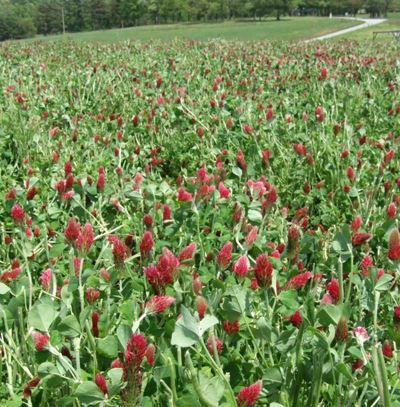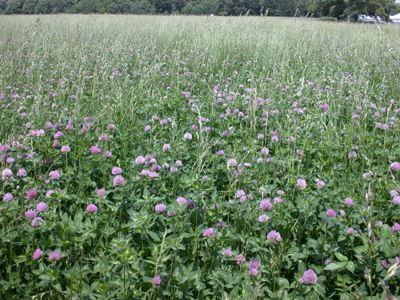Winter Annual Legumes Can Fill Forage Gap Between October-May
FAYETTEVILLE, ARK.
When bermudagrass goes dormant in the cold, winter annual legumes can
help span the forage gap between October and May, said Dirk Philipp,
assistant professor for the University of Arkansas System Division of
Agriculture.
“Winter annual legumes such as clover, are a good way of providing
forage in spring and add plant material to the soil,” Philipp said.

(Top Photo) Crimson blooms mark this annual clover, which can be a highly nutritious forage for cattle.
U of Arkansas System Division of Agriculture photo courtesy Dirk Philipp
(Photo Below) Clover adds nutritional value to forages while cutting the need for nitrogen fertilizers.
U of Arkansas System Division of Agriculture file photo courtesy John Jennings

With planting time in the southeastern U.S. ranging from the middle of
September to the middle of October, now is the time to make decisions.
In Arkansas, planting times range from Oct. 1 for the northern part of
the state to Oct. 15 for the southern part of the state.
Grazing
If the main goal for winter legumes is grazing, growers should know that
“initial grazing height varies with species, but plants should reach at
least 6-8 inches before grazing begins,” he said, adding that pastures
may “be rotationally stocked if grazing twice during spring is the
goal.”
The main advantage is to provide grazing and recycle accumulated plant
nutrients back to the soil, Philipp said. “This effect may be minor in
the short-term. If grazing is the goal, then focus should be on
optimizing forage use through appropriate stocking methods.”
Green manure
Legumes have been used as “green manure” for a very long time, and this
practice still continues today in many areas of the world, he said.
“Mostly, legumes need to be incorporated into the soil to receive
benefit from added plant biomass, organic material breakdown, and slow
release of nutrients,” Philipp said. “Since incorporation will damage
the perennial warm-season grasses, this option may have to be reserved
for areas where the annual legume is followed by a summer annual grass,
such as pearl millet.”
“The advantage of this approach is that plant biomass is recycled in a
broad manner and not just in a localized fashion if biomass passes
through animals and is deposited,” he said.
Dual uses
Maximizing the benefits of grazing and simultaneous nutrient recycling requires some planning and management efforts.
Legumes can be either overseeded into existing perennial grass pastures
or planted in separated areas that may increase higher establishment
success using somewhat higher seeding rates.
Philipp said that animals can be rotated between legume areas and
perennial grasses to avoid problems with a legume-only diet, which is
rich in protein. Rotating animals between paddocks has the added benefit
of “transferring nutrients away from the legume areas to the perennial
grass areas.”
Grazing tall fescue, a cool-season perennial grass, can begin in March
or April, which coincides with the graze-ability of annual legumes.
While the dietary benefits may be short term, over the long term, the
benefit will tip toward a longer-term increase in soil nutrients.
“When using annual legumes, success of establishment can vary over the
years and producers may have to experiment with different species and/or
varieties to synchronize forage needs by animals and forage growth as
much as possible,” Philipp said.∆